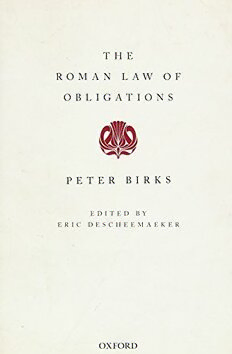
The Roman law of obligations PDF
Preview The Roman law of obligations
THE COLLECTED PAPERS OF PETER BIRKS The Roman Law of Obligations OUPCORRECTEDPROOF–FINAL,24/6/2014,SPi PeterBirksintheOldCollegelibrary,UniversityofEdinburgh(s) THE COLLECTED PAPERS OF PETER BIRKS The Roman Law of Obligations Peter Birks EDITED BY Eric Descheemaeker 1 3 GreatClarendonStreet,Oxford,OXDP, UnitedKingdom OxfordUniversityPressisadepartmentoftheUniversityofOxford. ItfurtherstheUniversity’sobjectiveofexcellenceinresearch,scholarship, andeducationbypublishingworldwide.Oxfordisaregisteredtrademarkof OxfordUniversityPressintheUKandincertainothercountries ©P.Birks,IntroductionbyE.Descheemaeker Themoralrightsoftheauthorshavebeenasserted FirstEditionpublishedin Impression: Allrightsreserved.Nopartofthispublicationmaybereproduced,storedin aretrievalsystem,ortransmitted,inanyformorbyanymeans,withoutthe priorpermissioninwritingofOxfordUniversityPress,orasexpresslypermitted bylaw,bylicenceorundertermsagreedwiththeappropriatereprographics rightsorganization.Enquiriesconcerningreproductionoutsidethescopeofthe aboveshouldbesenttotheRightsDepartment,OxfordUniversityPress,atthe addressabove Youmustnotcirculatethisworkinanyotherform andyoumustimposethissameconditiononanyacquirer CrowncopyrightmaterialisreproducedunderClassLicence NumberCPwiththepermissionofOPSI andtheQueen’sPrinterforScotland PublishedintheUnitedStatesofAmericabyOxfordUniversityPress MadisonAvenue,NewYork,NY,UnitedStatesofAmerica BritishLibraryCataloguinginPublicationData Dataavailable LibraryofCongressControlNumber: ISBN –––– Printedandboundby CPIGroup(UK)Ltd,Croydon,CRYY LinkstothirdpartywebsitesareprovidedbyOxfordingoodfaithand forinformationonly.Oxforddisclaimsanyresponsibilityforthematerials containedinanythirdpartywebsitereferencedinthiswork. Acknowledgements Iamgrateful,firstandforemost,toJacquelineBirksandAlexFlachfor their on-going help over the years in bringing this project to fruition; also to John Cairns and Ernest Metzger for their unstinting help and advice. ED Contents Tableof Legal Sources xi Tableof Ancient Non-Legal Sources xix Introduction xx . Obligations: The Conceptual Map . Definition: What is an Obligation? . Differentiation: Where doObligations Fitin the Roman View of the Law? i. The difference between rights in remandin personam ii. Differences between Gaius and Justinian iii. Outside the institutional scheme . Internal Organisation: How Are Obligations Arranged? i. The classification of obligations used by Gaius ii. The classification of obligations inStair Part I. Contracts . The Organisation of Roman Contract . Arrangement of the List inGaius’s andJustinian’sInstitutes . Formal and Informal Contracts . The Contract Litteris and the Rôleof WritingGenerally . Justinian’s Contract Litteris . The Rôle of Writing Outside Contracts Litteris . Arra . Writing and Stipulations . Contracts Verbis . Dotis Dictio (Declaration of Dowry) . Iusiurandum Liberti (Freedman’s Oath) . Stipulatio (Stipulation) i. What was the formality? ii. Why didstipulation not develop into a general law of contract complete initself? iii. What limits were there on the scope of stipulation? iv. Special applications of stipulation viii CONTENTS . Contracts Consensu . Emptio-Venditio (Sale) i. Thedemonstratio ii. Theintentio iii. The action against the buyer iv. Risk (periculum) v. The passing of property . Locatio-Conductio (Hire) i. Thedemonstratio ii. Theintentio . Societas (Partnership) i. Thedemonstratio ii. Theintentio iii. Thecondemnatio . Mandatum(Mandate, Commission or Agency) i. Thedemonstratio ii. Theintentio iii. Specialapplications . Contracts Re . Mutuum (Loan for Consumption) . Commodatum(Loan for Use) i. Thedemonstratio ii. Theintentio . Depositum(Deposit) i. Thedemonstratio ii. Theintentio . Pignus (Pledge) i. The contract ofpignus:the relationship between pledgor and pledgee ii. The relationship between pledgee and res Part II. Delicts . Furtum (Theft) . The Action . Paul’sDefinition . The Intent . The Act i. What did contrectatiomean to the high classics? ii. What did contrectatiomean to Justinian? iii. Was there an earlier doctrine and nomenclature? . The Absence of Consent CONTENTS ix . Liabilityfor Helping . Claimingthe Res . AVariety of Penalties . Rapina (Robbery) . Damnum Iniuria Datum (Loss Wrongfully Caused) . The Shapeof the Delict . The Statute . Interpretation inthe Statutory Core i. Hasthe plaintiff suffered loss (damnum)? ii. Didthat loss arise from a thing spoiled (res corrupta)? iii. Didthe spoiledthing belongto the plaintiff (res actoris)? iv. Didthe defendant dothe spoiling ‘corpore suo’? v. Didthe defendant dothe harm wrongfully (iniuria)? . The Praetorian Periphery i. Hasthe plaintiff suffered loss (damnum)? ii. Didthat loss arise from a thing spoiled (res corrupta)? iii. Didthe spoiledthing belongto the plaintiff (res actoris)? iv. Didthe defendant dothe spoiling ‘corpore suo’? v. Didthe defendant dothe harm wrongfully (iniuria)? . The Measure of Recovery i. Liscrescit (thesuit enlarges) ii. The original measure iii. Fullvalue underchapter III? iv. The measure inhigh classical law . Iniuria (Contempt) . The Name of the Delict . The Action . The Measure of Recovery . The Edictal Provisions i. Ofconvicium (shouted invective) ii. Ofaffronts to sexual propriety iii. ‘Let nothing be doneto cause infamy’ iv. The general edict de iniuriis . The Scope of the Classical Delict . The Classical Scope Re-StatedSummarily . Requirements inRelation to Intention . The History i. The edictal phase ii. The pre-edictal phase
